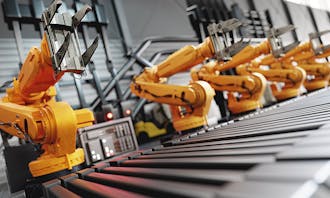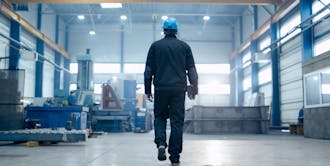- Home >
- Interviews >
-
Onn Fenig
Onn Fenig - 634AI
2021-08-18
5 min read

Q. Please can you give me an overview of 634AI and how the business was founded?
634AI was founded to enable safer, smarter autonomous indoor mobility for everyone, everywhere. The company was established as an answer to a specific pain point raised by one of our shareholders, Musashi Seimitsu, a global Tier 1 Japanese Auto parts manufacturer and a Honda Motor affiliate company. It wanted to eliminate the 20 per cent long tail of underutilised workforce in its worldwide factories, which has been engaged in manual material handling.
Driven by a vision of simplifying everyday mobile task fulfilment indoors, we’re on a mission to make any indoor task autonomous – from the industrial floor to the airport terminal, the warehouse floor, or the hospital floor, and beyond. 634AI offers practical and affordable tools for indoor mobility in the digital autonomy era.
Q. What are 634AI’s main products and services?
Our product is MAESTRO, the world’s first open API management software for industrial mobility, integrating RTLS driven productivity data, real-time safety, and mobile robots navigation and fleet management — all in a unified system and at a fraction of the price of existing solutions.
MAESTRO is a centralised Control Tower that enables effective and harmonised indoor operations. Its top-down visibility allows customers to experience a fully-coordinated operation of anything mobile. Be it track and trace movements of goods and equipment, real-time safety alerts for man-driven vehicles, or operating fleets of mobile robotic platforms (AGVs and AMRs) in crowded environments, MAESTRO understands everything in motion on the floor and orchestrates the action.
”
MAESTRO is leading the paradigm shift towards vision-based navigation with complete spatial awareness, enabling not only superior navigation capabilities of mobile robots based on AI, but also semantic applications that allow robots to understand their environment at a more sophisticated level.
”
Q. What is the main innovation you bring to the market?
MAESTRO is a proprietary vision-based Real-Time Location System, enabling dynamic object detection, classification, and location tracking. The advantages of computer vision and AI removes the need to pre tag objects with expensive hardware to detect or track them in real time. MAESTRO just sees it as it is and understands it, wherever it is, whenever it is.
MAESTRO is leading the paradigm shift towards vision-based navigation with complete spatial awareness, enabling not only superior navigation capabilities of mobile robots based on AI, but also semantic applications that allow robots to understand their environment at a more sophisticated level. Through its panoptic view of the floor, MAESTRO uses vision processing capabilities to put hardware in motion, synchronising indoor mobility of AMRs, man-driven vehicles, raw materials and human workers, for the first time through one integrated system.
Using industrial grade cameras to provide a continuous video stream of the floor from above, MAESTRO generates a ‘breathing’ map of the site. MAESTRO can provide spaghetti diagrams and Heat Maps and can show data like distance travelled and speed. It can map areas that are prone to safety events and provide real-time hazard alerts for man-driven vehicles, for obstacles in the horizon. Its vision capability can even be used to fully navigate vehicles.
Q. What is the greatest challenge that the company overcame?
AMRs are expensive equipment, far beyond the reach of many mid-sized companies. They also suffer from tunnel vision, with a limited ability to map and understand the entire environment and foresee safety events. Each of these AMRs, manufactured by different vendors, comes with its own operating, navigation, and fleet management system. This software bottleneck in AMR operations results in what is known as the interoperability problem.
634AI was able to overcome these major challenges by developing a proprietary architecture that enables cost-effective autonomy. MAESTRO’s vision-based navigation (vSLAM) enables users to strip the vehicle from the expensive hardware components traditionally used for navigation, replacing them with one, centralised, AI-powered brain. The brain is shifted from each end device to a central processing unit which takes full responsibility of floor semantics as well as the AMR navigation. This reduces the costs of traditional robotic platforms because the expensive hardware associated with navigation isn’t necessary.
This unique central control architecture enables cost-reduction for the robotic platform itself and is completely agnostic to the robot.
MAESTRO’s panoptic view of the floor, powered by a centralised AI engine, enables it to generate tasks for mobile robots completely autonomously across the floor, understanding and navigating the robots effectively and in sync with all other moving objects. This achieves not only AMR interoperability, but full floor interoperability – coordinating the work of AMRs, AGVs, man driven forklifts, raw material movement and people movement on the floor – all in sync and with greater safety.
With MAESTRO, there is no need to pre-tag objects with an additional electromagnetic radiation emitting hardware components, AMRs can be dramatically cheaper, with better floor understanding and completely interoperable with any other mobile devices on the floor, via one management software, at an affordable price.
Q. How do your products and services tie into the growing use of automation in manufacturing?
As the manufacturing sector transitions to be more automated, MAESTRO provides a solution that works for today and tomorrow, compatible with greenfield and brownfield operations, human workers, forklifts, existing AGVs and future AMR adoption.
MAESTRO can streamline processes not just on a micro but on a macro level too. Rather than streamlining the flow of each individual AMR, it can ensure that the entire operation is working in tandem for maximum optimisation. By reducing inconsistencies on the manufacturing floor, MAESTRO supports the machines and the people on the ground, improving coordination and job alignment across the board. For example, MAESTRO can improve the allocation of forklift drivers to forklifts by being able to monitor in real time the location of each forklift and alert a forklift driver of the proximity to an AGV, another forklift, a person, or a static obstacle even out of the line of sight.
Hardware with the level of sophistication required for an AMR to react to its changing surroundings is often extremely expensive and requires many engineers and technicians for maintenance, as well as being exclusive to specific manufacturers. MAESTRO provides a solution that can allow for greater implementation of AMRs across the cost-spectrum, easing manufacturing into the future of AMR technologies without throwing out everything they have built so far.
Sign up for updates.
Try these
You might also like

Interview
John Young - EU Automation
Implementing an automation system without first thoroughly planning your approach can be a very risk...

Interview
Neil Ballinger - EU Automation
Have a plan to manage the risks. Planning ahead rather than reacting to failures gives you a competi...

Interview
Jon Brewin - AutoStore
AutoStore is the cube storage pioneer, inventing the technology and using the last few decades to pu...



